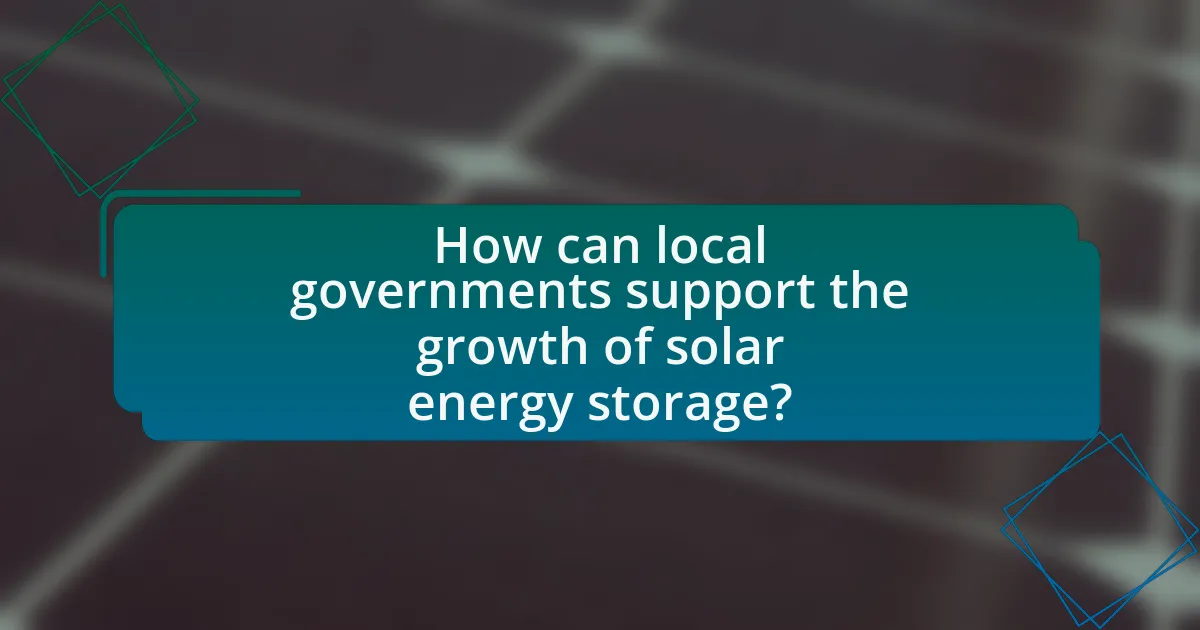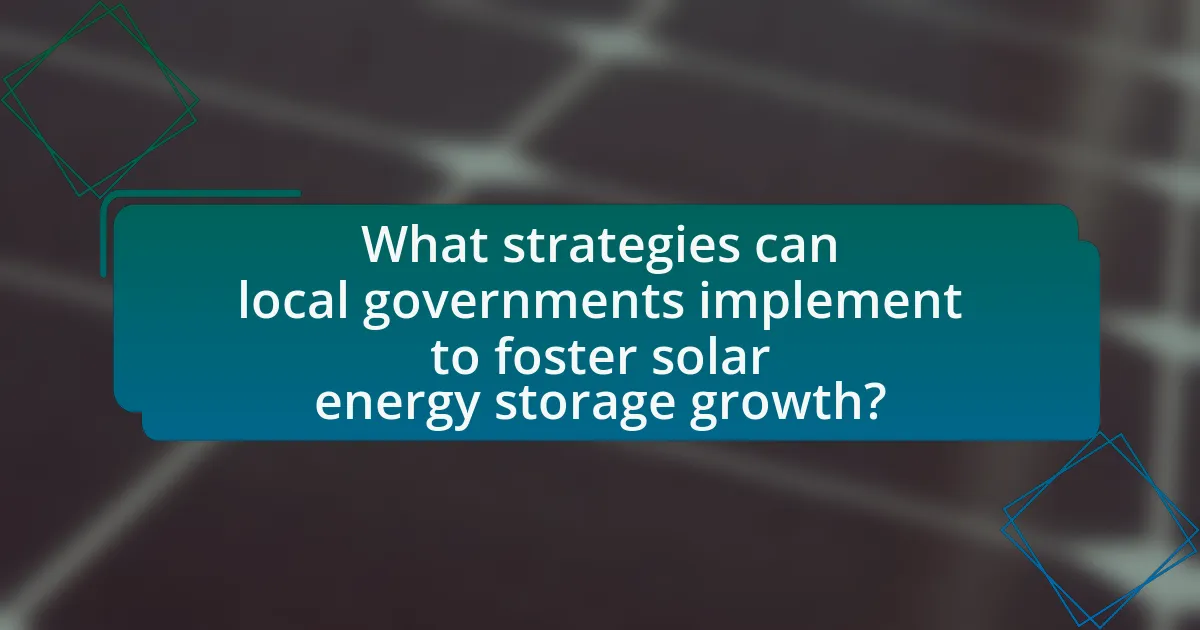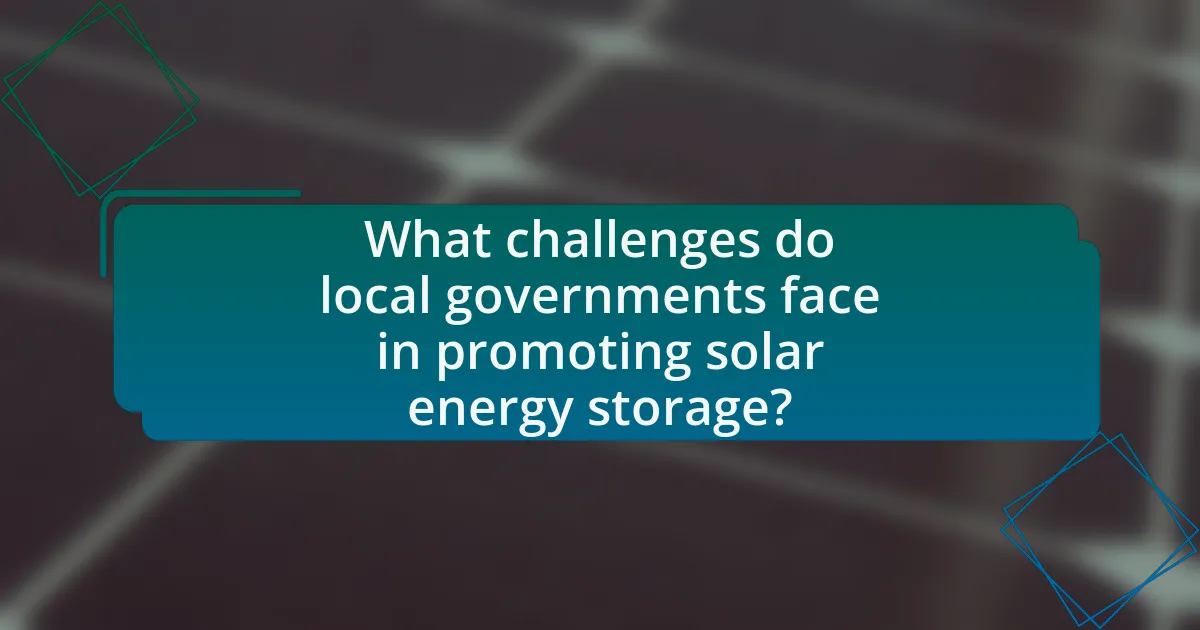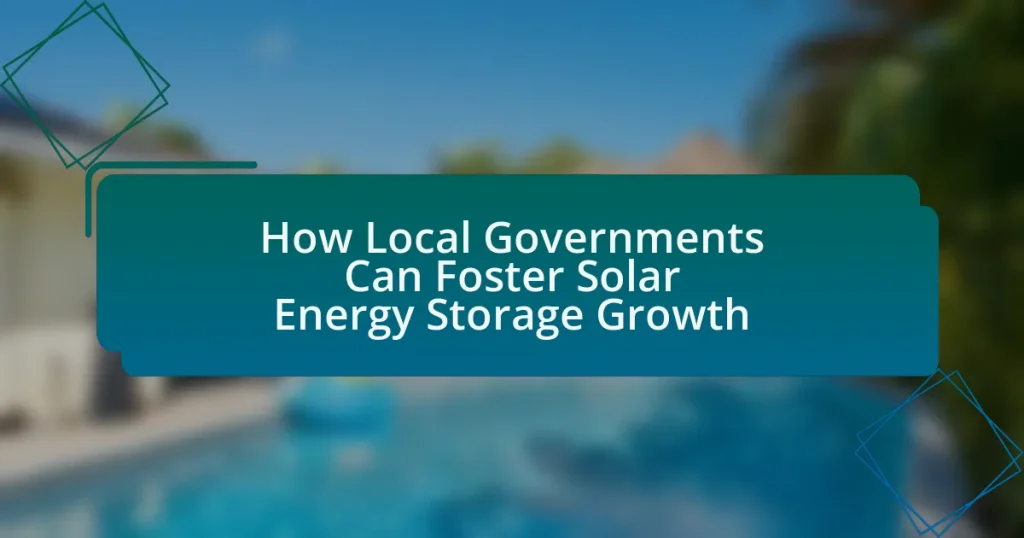Local governments play a vital role in fostering the growth of solar energy storage through the implementation of supportive policies, financial incentives, and community engagement initiatives. Key strategies include offering tax credits, rebates, and grants to reduce installation costs, streamlining permitting processes to facilitate quicker project deployment, and establishing educational programs to raise public awareness. The article explores the influence of local policies on solar energy storage adoption, funding opportunities available for projects, and the environmental and economic benefits for communities. Additionally, it addresses the challenges local governments face, such as regulatory hurdles and funding limitations, while highlighting best practices for successful implementation of solar energy storage programs.
How can local governments support the growth of solar energy storage?


Local governments can support the growth of solar energy storage by implementing policies that incentivize investment in solar technologies and storage systems. These policies can include tax credits, rebates, and grants specifically aimed at homeowners and businesses that install solar energy storage solutions. For instance, the Solar Investment Tax Credit (ITC) in the United States has been instrumental in boosting solar installations by allowing a significant percentage of the installation costs to be deducted from federal taxes. Additionally, local governments can streamline permitting processes to reduce barriers for solar storage projects, making it easier and faster for developers to bring these systems online. By establishing community solar programs, local governments can also facilitate access to solar energy for residents who may not have suitable rooftops for solar panels, thereby expanding the market for solar energy storage.
What are the key roles of local governments in promoting solar energy storage?
Local governments play a crucial role in promoting solar energy storage by implementing supportive policies, providing financial incentives, and facilitating community engagement. They establish regulations that encourage the installation of solar energy systems and storage solutions, such as streamlined permitting processes and zoning laws that favor renewable energy projects. Additionally, local governments often offer grants, tax credits, or rebates to reduce the financial burden on residents and businesses investing in solar storage technologies. Furthermore, they engage with the community through educational programs and workshops to raise awareness about the benefits of solar energy storage, thereby fostering a culture of sustainability. These actions collectively contribute to increased adoption of solar energy storage solutions at the local level.
How do local policies influence solar energy storage adoption?
Local policies significantly influence solar energy storage adoption by establishing regulatory frameworks, financial incentives, and permitting processes that either facilitate or hinder the integration of storage technologies. For instance, policies that offer tax credits or rebates for solar energy storage systems can increase consumer interest and investment, as evidenced by California’s Self-Generation Incentive Program, which has led to a substantial rise in residential battery installations. Additionally, streamlined permitting processes reduce barriers to installation, encouraging more homeowners and businesses to adopt solar storage solutions. Conversely, restrictive zoning laws or lack of supportive regulations can impede growth, demonstrating that local governance plays a crucial role in shaping the solar energy storage landscape.
What funding opportunities can local governments provide for solar energy storage projects?
Local governments can provide funding opportunities for solar energy storage projects through grants, low-interest loans, and tax incentives. Grants can be allocated to support the initial capital costs of solar energy storage systems, while low-interest loans can help finance these projects over time, making them more accessible for local businesses and residents. Additionally, tax incentives, such as property tax exemptions or sales tax rebates, can reduce the overall financial burden on project developers and homeowners investing in solar energy storage. These funding mechanisms have been successfully implemented in various regions, demonstrating their effectiveness in promoting renewable energy initiatives. For instance, the California Solar Initiative has provided substantial rebates for solar installations, which can include energy storage components, thereby encouraging widespread adoption.
Why is solar energy storage important for local communities?
Solar energy storage is important for local communities because it enhances energy reliability and promotes sustainability. By storing excess solar energy generated during the day, communities can utilize this energy during peak demand times or during outages, reducing reliance on fossil fuels and enhancing grid stability. According to the U.S. Department of Energy, energy storage can help integrate renewable energy sources, leading to a more resilient energy system. Additionally, communities that invest in solar energy storage can lower energy costs and create local jobs in the renewable energy sector, contributing to economic growth.
How does solar energy storage enhance energy resilience in communities?
Solar energy storage enhances energy resilience in communities by providing a reliable backup power source during outages and peak demand periods. This capability allows communities to maintain essential services, such as healthcare and emergency response, even when the main power grid is compromised. Additionally, solar energy storage systems can reduce reliance on fossil fuels, thereby decreasing greenhouse gas emissions and promoting environmental sustainability. According to the U.S. Department of Energy, integrating energy storage with solar power can lead to a more stable and flexible energy system, which is crucial for adapting to climate change and increasing energy demands.
What environmental benefits does solar energy storage offer to local areas?
Solar energy storage provides significant environmental benefits to local areas by reducing reliance on fossil fuels and decreasing greenhouse gas emissions. By storing solar energy for use during peak demand times, communities can minimize the need for conventional power plants, which often rely on coal or natural gas, thus lowering air pollution levels. According to the U.S. Environmental Protection Agency, transitioning to renewable energy sources like solar can reduce carbon dioxide emissions by up to 80% compared to fossil fuel sources. Additionally, solar energy storage enhances grid resilience, allowing local areas to maintain power during outages and reducing the environmental impact associated with emergency power generation.
What strategies can local governments implement to foster solar energy storage growth?


Local governments can implement financial incentives, regulatory support, and educational programs to foster solar energy storage growth. Financial incentives, such as tax credits and rebates for solar storage installations, can significantly reduce upfront costs for consumers and businesses, encouraging adoption. Regulatory support, including streamlined permitting processes and interconnection standards, can facilitate quicker and more efficient installations. Additionally, educational programs that inform the public about the benefits of solar energy storage can increase awareness and drive demand. For instance, a study by the National Renewable Energy Laboratory found that states with strong incentive programs saw a 50% increase in solar installations compared to those without such measures.
How can local governments create incentives for solar energy storage adoption?
Local governments can create incentives for solar energy storage adoption by implementing financial subsidies, tax credits, and streamlined permitting processes. Financial subsidies can lower the upfront costs for consumers, making solar energy storage systems more accessible. Tax credits, such as those offered in various states, can further reduce the financial burden, encouraging homeowners and businesses to invest in these technologies. Additionally, streamlined permitting processes can expedite installation, reducing delays and costs associated with regulatory compliance. These strategies have been shown to increase adoption rates; for instance, states that offer tax incentives have seen a significant rise in solar installations, demonstrating the effectiveness of such measures.
What types of financial incentives are most effective for encouraging solar energy storage?
Tax credits and rebates are the most effective financial incentives for encouraging solar energy storage. These incentives reduce the upfront costs for consumers, making solar energy storage systems more accessible. For instance, the Federal Investment Tax Credit (ITC) allows homeowners to deduct a significant percentage of the cost of solar energy systems from their federal taxes, which has been shown to increase adoption rates. Additionally, state-level rebates can further lower costs; for example, California offers rebates that can cover a substantial portion of the installation expenses. Studies indicate that these financial incentives lead to higher installation rates, with a report from the National Renewable Energy Laboratory showing that states with robust incentive programs see up to 50% more solar installations compared to those without.
How can local governments streamline permitting processes for solar energy storage installations?
Local governments can streamline permitting processes for solar energy storage installations by implementing standardized application forms and expedited review timelines. Standardization reduces confusion and ensures consistency, while expedited timelines can significantly decrease the waiting period for approvals. For instance, jurisdictions that have adopted a streamlined permitting process, such as California’s Solar Permitting Guidebook, have reported reductions in approval times from weeks to just a few days, facilitating faster project deployment. Additionally, providing clear guidelines and resources for applicants can further enhance efficiency, as seen in cities that offer online permitting systems, which allow for quicker submissions and tracking of applications.
What partnerships can local governments form to enhance solar energy storage initiatives?
Local governments can enhance solar energy storage initiatives by forming partnerships with private solar companies, utility providers, research institutions, and community organizations. Collaborating with private solar companies allows local governments to leverage expertise in technology and installation, facilitating the deployment of solar storage systems. Partnering with utility providers can enable access to grid infrastructure and financial incentives, such as rebates or grants, which can lower costs for residents. Engaging with research institutions can foster innovation and provide data-driven insights into effective storage solutions, while collaboration with community organizations can help raise awareness and promote local adoption of solar energy technologies. These partnerships collectively contribute to a more robust solar energy storage ecosystem, evidenced by successful initiatives in cities like San Diego, which has seen significant growth in solar installations through collaborative efforts.
How can collaboration with private sector companies benefit solar energy storage projects?
Collaboration with private sector companies can significantly enhance solar energy storage projects by providing access to advanced technologies and capital investment. Private companies often possess innovative solutions and expertise in energy storage systems, which can lead to improved efficiency and performance of solar energy projects. For instance, partnerships can facilitate the integration of cutting-edge battery technologies, such as lithium-ion or flow batteries, which have been shown to increase energy retention and reduce costs. Additionally, private sector involvement can attract funding and resources, enabling local governments to scale projects more effectively. According to a report by the International Renewable Energy Agency, investments in energy storage technologies are projected to reach $620 billion by 2040, highlighting the financial potential of such collaborations.
What role do non-profit organizations play in supporting local solar energy storage efforts?
Non-profit organizations play a crucial role in supporting local solar energy storage efforts by providing funding, education, and advocacy. These organizations often secure grants and donations to finance solar projects, making renewable energy more accessible to communities. For instance, the Solar Energy Foundation has successfully funded solar initiatives in underserved areas, demonstrating the impact of non-profit funding on local energy solutions. Additionally, non-profits educate the public about the benefits of solar energy storage, helping to increase community engagement and awareness. They also advocate for policies that support solar energy development, influencing local government decisions to foster an environment conducive to solar growth.
What challenges do local governments face in promoting solar energy storage?


Local governments face several challenges in promoting solar energy storage, including regulatory hurdles, funding limitations, and public awareness issues. Regulatory hurdles often stem from outdated policies that do not accommodate new technologies, making it difficult for local governments to implement effective solar energy storage solutions. Funding limitations arise from budget constraints and the need for upfront capital investment, which can deter local governments from pursuing solar initiatives. Additionally, public awareness issues hinder adoption, as many residents may lack understanding of the benefits and functionalities of solar energy storage systems. These challenges collectively impede the growth of solar energy storage at the local level.
How can local governments address regulatory barriers to solar energy storage?
Local governments can address regulatory barriers to solar energy storage by streamlining permitting processes and updating zoning laws to accommodate energy storage systems. By simplifying the application procedures, local governments can reduce the time and costs associated with installing solar energy storage, which encourages adoption. Additionally, revising zoning regulations to allow for the installation of storage systems in residential and commercial areas can eliminate restrictions that currently hinder development. For instance, the National Renewable Energy Laboratory found that regulatory delays can add significant costs to solar projects, highlighting the importance of efficient local policies in promoting solar energy storage growth.
What are common regulatory hurdles that impede solar energy storage growth?
Common regulatory hurdles that impede solar energy storage growth include restrictive zoning laws, inadequate interconnection standards, and lack of financial incentives. Restrictive zoning laws can limit the installation of solar energy systems and storage facilities, making it difficult for developers to find suitable locations. Inadequate interconnection standards can delay or complicate the process of connecting storage systems to the grid, hindering deployment. Additionally, the absence of financial incentives, such as tax credits or rebates, can deter investment in solar energy storage projects, as seen in various regions where such incentives have proven effective in promoting growth.
How can local governments advocate for policy changes to support solar energy storage?
Local governments can advocate for policy changes to support solar energy storage by engaging in collaborative efforts with stakeholders, including community members, businesses, and energy experts. They can initiate public forums and workshops to raise awareness about the benefits of solar energy storage, thereby building community support. Additionally, local governments can draft and propose legislation that incentivizes solar energy storage, such as tax credits or grants for installation. Evidence from the National Renewable Energy Laboratory indicates that policies promoting energy storage can lead to a 30% increase in solar adoption rates. By leveraging data and case studies, local governments can effectively communicate the economic and environmental advantages of solar energy storage to policymakers, thereby influencing legislative changes.
What are the financial challenges local governments encounter in solar energy storage initiatives?
Local governments encounter significant financial challenges in solar energy storage initiatives, primarily due to high upfront capital costs and ongoing maintenance expenses. The initial investment required for solar energy storage systems can be substantial, often exceeding millions of dollars, which strains local budgets. Additionally, the lack of consistent funding sources and financial incentives complicates the ability of local governments to secure necessary financing. For instance, a report from the National Renewable Energy Laboratory indicates that while the cost of solar technology has decreased, the integration of storage systems still presents a financial barrier, with costs averaging around $400 to $600 per kilowatt-hour for battery storage. Furthermore, local governments often face uncertainty regarding the return on investment, as the economic viability of solar storage projects can fluctuate based on energy market conditions and regulatory changes.
How can local governments secure funding for solar energy storage projects?
Local governments can secure funding for solar energy storage projects by applying for federal and state grants, utilizing public-private partnerships, and leveraging tax incentives. For instance, the U.S. Department of Energy offers various funding opportunities through programs like the Solar Energy Technologies Office, which has allocated millions in grants for solar-related initiatives. Additionally, local governments can collaborate with private companies to share costs and resources, enhancing project viability. Tax incentives, such as the Investment Tax Credit, can also significantly reduce upfront costs, making projects more attractive to investors.
What strategies can be employed to reduce the costs associated with solar energy storage?
To reduce the costs associated with solar energy storage, local governments can implement strategies such as incentivizing bulk purchasing of storage systems, promoting research and development for more efficient technologies, and establishing supportive regulatory frameworks. Incentivizing bulk purchasing can lower unit costs through economies of scale, as seen in programs that allow communities to collectively buy storage solutions, resulting in significant savings. Promoting research and development can lead to advancements in battery technology, which historically have reduced costs; for example, the price of lithium-ion batteries has dropped by over 80% since 2010 due to innovation and increased production. Establishing supportive regulatory frameworks can streamline permitting processes and provide financial incentives, which can further lower the overall costs for consumers and businesses investing in solar energy storage.
What best practices can local governments adopt to successfully implement solar energy storage programs?
Local governments can successfully implement solar energy storage programs by establishing clear policies and incentives that promote investment in solar technologies. These policies should include financial incentives such as tax credits, grants, and rebates for both residential and commercial solar energy storage systems, which have been shown to increase adoption rates significantly.
Additionally, local governments should facilitate partnerships with private sector companies to leverage expertise and resources, as evidenced by successful collaborations in cities like San Diego, where public-private partnerships have led to innovative solar storage solutions.
Furthermore, conducting community outreach and education initiatives can raise awareness about the benefits of solar energy storage, thereby increasing public support and participation. Research indicates that informed communities are more likely to engage in renewable energy programs, as seen in various case studies across the United States.
Lastly, integrating solar energy storage into existing energy infrastructure and planning for grid resilience can enhance the effectiveness of these programs, ensuring that they contribute to overall energy sustainability and reliability.
How can local governments effectively engage with their communities about solar energy storage?
Local governments can effectively engage with their communities about solar energy storage by implementing educational programs and outreach initiatives that inform residents about the benefits and opportunities of solar energy storage systems. These programs can include workshops, informational sessions, and online resources that explain how solar energy storage works, its cost savings, and its environmental impact.
For instance, a study by the National Renewable Energy Laboratory found that community engagement significantly increases public acceptance and adoption of renewable energy technologies. By actively involving community members in discussions and decision-making processes, local governments can build trust and encourage participation in solar energy storage initiatives.
What metrics should local governments use to evaluate the success of solar energy storage initiatives?
Local governments should use metrics such as energy capacity, cost savings, greenhouse gas emissions reduction, and community engagement to evaluate the success of solar energy storage initiatives. Energy capacity measures the total amount of energy stored and utilized, indicating the effectiveness of the storage systems. Cost savings can be assessed by comparing energy bills before and after implementation, demonstrating financial benefits to residents and businesses. Greenhouse gas emissions reduction can be quantified by calculating the decrease in fossil fuel reliance due to solar energy usage, contributing to environmental goals. Community engagement metrics, such as participation rates in programs and feedback from residents, provide insight into public support and awareness of solar initiatives. These metrics collectively offer a comprehensive view of the initiative’s impact and effectiveness.


